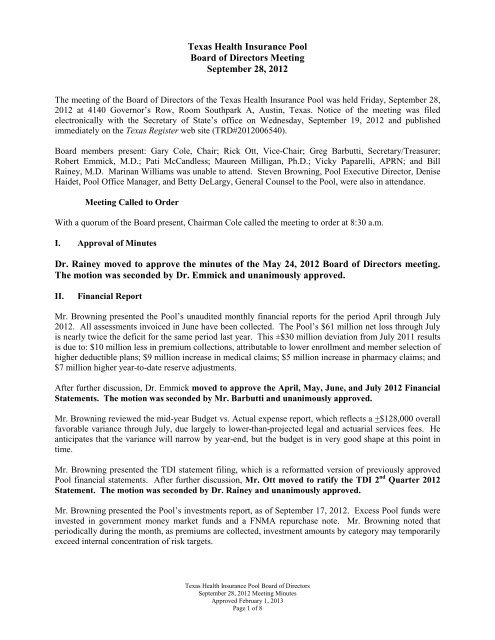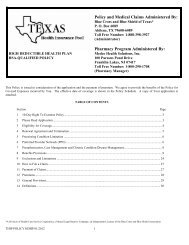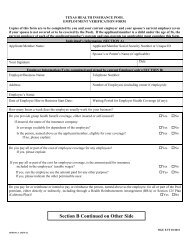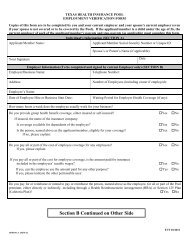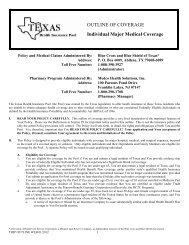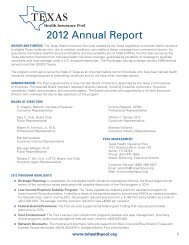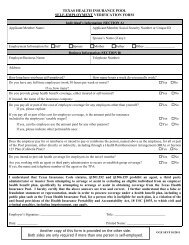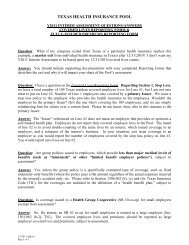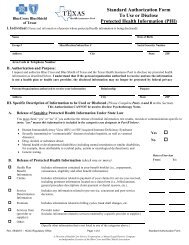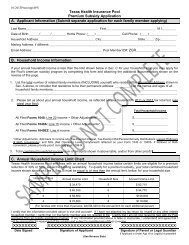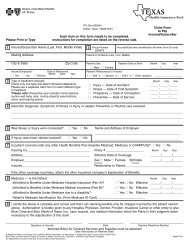September 28, 2012 - Texas Health Insurance Risk Pool
September 28, 2012 - Texas Health Insurance Risk Pool
September 28, 2012 - Texas Health Insurance Risk Pool
You also want an ePaper? Increase the reach of your titles
YUMPU automatically turns print PDFs into web optimized ePapers that Google loves.
<strong>Texas</strong> <strong>Health</strong> <strong>Insurance</strong> <strong>Pool</strong><br />
Board of Directors Meeting<br />
<strong>September</strong> <strong>28</strong>, <strong>2012</strong><br />
The meeting of the Board of Directors of the <strong>Texas</strong> <strong>Health</strong> <strong>Insurance</strong> <strong>Pool</strong> was held Friday, <strong>September</strong> <strong>28</strong>,<br />
<strong>2012</strong> at 4140 Governor’s Row, Room Southpark A, Austin, <strong>Texas</strong>. Notice of the meeting was filed<br />
electronically with the Secretary of State’s office on Wednesday, <strong>September</strong> 19, <strong>2012</strong> and published<br />
immediately on the <strong>Texas</strong> Register web site (TRD#<strong>2012</strong>006540).<br />
Board members present: Gary Cole, Chair; Rick Ott, Vice-Chair; Greg Barbutti, Secretary/Treasurer;<br />
Robert Emmick, M.D.; Pati McCandless; Maureen Milligan, Ph.D.; Vicky Paparelli, APRN; and Bill<br />
Rainey, M.D. Marinan Williams was unable to attend. Steven Browning, <strong>Pool</strong> Executive Director, Denise<br />
Haidet, <strong>Pool</strong> Office Manager, and Betty DeLargy, General Counsel to the <strong>Pool</strong>, were also in attendance.<br />
Meeting Called to Order<br />
With a quorum of the Board present, Chairman Cole called the meeting to order at 8:30 a.m.<br />
I. Approval of Minutes<br />
Dr. Rainey moved to approve the minutes of the May 24, <strong>2012</strong> Board of Directors meeting.<br />
The motion was seconded by Dr. Emmick and unanimously approved.<br />
II.<br />
Financial Report<br />
Mr. Browning presented the <strong>Pool</strong>’s unaudited monthly financial reports for the period April through July<br />
<strong>2012</strong>. All assessments invoiced in June have been collected. The <strong>Pool</strong>’s $61 million net loss through July<br />
is nearly twice the deficit for the same period last year. This ±$30 million deviation from July 2011 results<br />
is due to: $10 million less in premium collections, attributable to lower enrollment and member selection of<br />
higher deductible plans; $9 million increase in medical claims; $5 million increase in pharmacy claims; and<br />
$7 million higher year-to-date reserve adjustments.<br />
After further discussion, Dr. Emmick moved to approve the April, May, June, and July <strong>2012</strong> Financial<br />
Statements. The motion was seconded by Mr. Barbutti and unanimously approved.<br />
Mr. Browning reviewed the mid-year Budget vs. Actual expense report, which reflects a +$1<strong>28</strong>,000 overall<br />
favorable variance through July, due largely to lower-than-projected legal and actuarial services fees. He<br />
anticipates that the variance will narrow by year-end, but the budget is in very good shape at this point in<br />
time.<br />
Mr. Browning presented the TDI statement filing, which is a reformatted version of previously approved<br />
<strong>Pool</strong> financial statements. After further discussion, Mr. Ott moved to ratify the TDI 2 nd Quarter <strong>2012</strong><br />
Statement. The motion was seconded by Dr. Rainey and unanimously approved.<br />
Mr. Browning presented the <strong>Pool</strong>’s investments report, as of <strong>September</strong> 17, <strong>2012</strong>. Excess <strong>Pool</strong> funds were<br />
invested in government money market funds and a FNMA repurchase note. Mr. Browning noted that<br />
periodically during the month, as premiums are collected, investment amounts by category may temporarily<br />
exceed internal concentration of risk targets.<br />
<strong>Texas</strong> <strong>Health</strong> <strong>Insurance</strong> <strong>Pool</strong> Board of Directors<br />
<strong>September</strong> <strong>28</strong>, <strong>2012</strong> Meeting Minutes<br />
Approved February 1, 2013<br />
Page 1 of 8
III.<br />
Executive Director’s Report<br />
Mr. Browning presented the Board of Directors Summary key metrics report, with updated results through<br />
July <strong>2012</strong>. Comparing YTD<strong>2012</strong> to the same period last year, the average premium per member per month<br />
(PMPM) increased only 2%, to $713. In contrast, claims expense PMPM increased 24%, to $1048. As<br />
<strong>Pool</strong> enrollment declines, enrollees with higher claim costs are remaining in the <strong>Pool</strong>, applying upward<br />
pressure on the PMPM claims figure. Application volumes continue to drop. Mr. Browning reported that<br />
the <strong>Pool</strong> is losing a net ±150 members monthly, due largely to an increasing number of members attaining<br />
age 65. In the last three months alone, the <strong>Pool</strong> lost 600 members because they turned 65. Upward<br />
deductible migration continues, with 25% of <strong>Pool</strong> policyholders now enrolled in the $7,500 plan.<br />
Mr. Browning reviewed the updated timeline and noted that the 83 rd legislative session begins January 8,<br />
2013. Discussion ensued about the best timing for the possible filing of a bill to revise the <strong>Pool</strong> statute to<br />
reflect changes required by the Affordable Care Act. Ms. McCandless suggested filing the bill as early as<br />
possible, certainly by January.<br />
Mr. Browning provided an update for the low-income premium subsidy program, and discussed the chart<br />
that tracks penalty collections and enrollment in the program. Since March of this year, premium subsidy<br />
applications have been mailed on a weekly basis to new enrollees, immediately after their enrollment in the<br />
<strong>Pool</strong>. This process puts the subsidy application into new enrollees’ hands within ±10 days of <strong>Pool</strong><br />
enrollment. In addition, a copy of the subsidy application was posted to the <strong>Pool</strong> website, and is inserted<br />
into each mailed <strong>Pool</strong> application packet, so that <strong>Pool</strong> applicants can prequalify their eligibility for the<br />
subsidy program. Prompt pay penalty amounts remitted by the carriers still vary widely, but have increased<br />
to a monthly average of $1.4 million this year, with a couple of large carriers accounting for the increased<br />
penalty volume.<br />
Mr. Browning presented a rolling two-month customer service report, prepared by Blue Cross Blue Shield<br />
of <strong>Texas</strong> (BCBSTX), that provides a weekly update of key service categories, including speed of answer,<br />
claim processing, and application volumes.<br />
IV.<br />
Board Issues and Administrative Matters<br />
Mr. Browning presented the recommendations of the joint Benefits Review & Y2014 Planning Work<br />
Group, which met several times. The group was comprised of Mr. Barbutti, Mr. Cole, Ms. McCandless,<br />
and Ms. Milligan. The Group’s final recommendations for Board approval are as follows:<br />
1) Deductible Reduction Opportunity: This item is an administrative recommendation to allow an open<br />
enrollment period later this year for members to elect a lower deductible plan. This opportunity was last<br />
offered by the Board in 2006, when ±300 <strong>Pool</strong> members elected to lower their deductibles. Because<br />
financial circumstances change over time, the <strong>Pool</strong> receives periodic requests from members to lower their<br />
deductibles. Milliman priced the cost of the exception, and concluded there would be minimal impact on<br />
the <strong>Pool</strong>’s annual net loss, likely no more than ±$200,000. If approved, the election period would run from<br />
November through year-end, with a January 1, 2013 effective date. Members who elect to lower deductible<br />
during this option period must remain in that lower deductible, higher premium plan throughout Y2013.<br />
2) Revision to Claim Filing Deadline: The Work Group spent time discussing possible discontinuation of<br />
<strong>Pool</strong> operations, and the importance of compressing timelines for claim and lawsuit filings, so that<br />
dissolution could occur in a reasonable time frame. The <strong>Pool</strong> policy currently allows members to file<br />
claims up to one year plus 90 days after the date of service, but with an incompetency clause that is<br />
completely open-ended. The Work Group recommends shortening the claim filing deadline to one year<br />
after the incurred service date and eliminating the open-ended incompetency clause. Providers, who file the<br />
majority of claims, already submit a very high percentage of claims within a short time frame. The<br />
<strong>Texas</strong> <strong>Health</strong> <strong>Insurance</strong> <strong>Pool</strong> Board of Directors<br />
<strong>September</strong> <strong>28</strong>, <strong>2012</strong> Meeting Minutes<br />
Approved February 1, 2013<br />
Page 2 of 8
proposed change would still provide a reasonable time period to file.<br />
3) Revision to Legal Actions Deadline: The Work Group also discussed the <strong>Pool</strong>’s lawsuit filing deadline.<br />
The current policy provision allows filing of a legal action against the <strong>Pool</strong> up to three years after a claim is<br />
denied. The recommendation is to shorten the <strong>Pool</strong>’s legal action filing deadline to correspond to <strong>Texas</strong><br />
contract law, which requires a minimum of two years after the date a cause of action arises. This<br />
compressed time frame would still provide a reasonable period of time for a legal action filing. Mr.<br />
Browning observed that, until the claim and lawsuit filing provisions are revised, the potential for a much<br />
later filed suit could extend the period of <strong>Pool</strong> run-out; reasonable compression of the time frames will<br />
expedite the future dissolution process. Discussion ensued about the likelihood that, even with these<br />
revisions, there could be some sort of final public notice to provide a definite cut-off date for all claims and<br />
causes of action against the <strong>Pool</strong>.<br />
After further discussion, Ms. McCandless moved to approve the Work Group’s recommendation to<br />
allow enrollees to lower their deductibles, as an administrative exception to the <strong>Pool</strong> policy, during an<br />
election period ending 12/31/<strong>2012</strong>. The reduction would be effective 1/1/2013, and those electing to<br />
lower their deductibles would not be permitted to increase their deductibles during 2013. Dr.<br />
Emmick seconded the motion and it was unanimously approved.<br />
After further discussion, Dr. Emmick moved to approve the Work Group’s recommendations to: 1)<br />
require claim filing within one year of the incurred date and remove the incompetency clause; and 2)<br />
require legal actions to be filed within 2 years of the cause of action date. Both revisions are subject<br />
to Commissioner approval. Mr. Barbutti seconded the motion and it was unanimously approved.<br />
Mr. Browning presented the elements of a bill considered by the Work Group, which would be filed in the<br />
next legislative session to address the possible wind down of the <strong>Pool</strong>, assuming the Affordable Care Act is<br />
not repealed. Without repeal, availability of coverage in the individual health insurance market will be<br />
guaranteed, without medical underwriting, beginning January 1, 2014, and therefore it is anticipated that the<br />
<strong>Pool</strong> would discontinue new enrollment at that time.<br />
Another issue, likely to be addressed by the Legislature, is the date the <strong>Pool</strong> will terminate in-force policies.<br />
The open enrollment period for purchase of individual coverage through the Exchange is October 2013<br />
through March 2014; unless an individual qualifies for special enrollment, coverage is not available again<br />
until January 1, 2015. The <strong>Pool</strong> will need to educate its membership about the Exchange and the<br />
enrollment deadlines. There was discussion about the possibility of maintaining <strong>Pool</strong> coverage through<br />
2014 for members enrolled as of December 31, 2013, to mitigate some of the impact on premium rates of<br />
the transition of so many high-cost claimants into the commercial market. Extensive discussion ensued<br />
about the planning now taking place in other states regarding risk pools, and what may happen to premium<br />
rates in the individual health insurance market after December 31, 2013. Mr. Barbutti observed that he<br />
would want the <strong>Pool</strong> to either offer continued coverage to in-force enrollees throughout 2014 or,<br />
alternatively, cancel all coverage effective January 1, 2014, so that insureds do not face two deductibles<br />
within the same calendar year.<br />
After further discussion, Mr. Barbutti moved to recommend seeking legislative support for filing a bill<br />
during the 83 rd session, as generally outlined in the Work Group recommendation, to prepare for<br />
possible dissolution of the <strong>Pool</strong> in 2014. Mr. Ott seconded the motion and it was unanimously<br />
approved.<br />
Ms. Sue Hart presented Milliman’s financial projections for the <strong>Pool</strong>, which serve as the basis for<br />
developing carrier assessments. She noted that the projections cover a 15-month time period; therefore, a<br />
<strong>Texas</strong> <strong>Health</strong> <strong>Insurance</strong> <strong>Pool</strong> Board of Directors<br />
<strong>September</strong> <strong>28</strong>, <strong>2012</strong> Meeting Minutes<br />
Approved February 1, 2013<br />
Page 3 of 8
wide range of assessment projection results are possible, varying from ±$140 million to ±$192 million,<br />
depending on the claim trend and enrollment assumptions applied. The mid-range estimate to maintain a<br />
positive cash balance through December 2013 is $165.1 million. To be conservative, no premium increases<br />
are assumed. Last year’s interim assessment was only $125.5 million, but in hindsight it should have been<br />
±$135 million to fully cover the <strong>Pool</strong>’s costs through the end of this year. Therefore, ±$10 million of the<br />
proposed $165.1 million interim amount is attributable to a shortfall in last year’s assessment amount.<br />
Further discussion ensued regarding cost trends anticipated next year.<br />
After further discussion, Mr. Barbutti moved to approve the Y<strong>2012</strong> Interim Assessment in the amount<br />
of $165.1 million. The assessment will be payable in two installments, with the first installment of<br />
$82,550,000 due within 30 days of the final invoice date and the remainder due six months thereafter.<br />
Dr. Emmick seconded the motion and it was unanimously approved.<br />
Mr. Browning noted that at each Fall meeting the Board authorizes him to obtain a line of credit, if required<br />
to maintain a positive cash balance before the assessments are collected. He estimates the <strong>Pool</strong> will have at<br />
least $5 million in cash on hand by the end of November, based on projected timing of claim payments.<br />
Therefore, he does not anticipate needing to draw funds under the line of credit, but agreed it is a good idea<br />
to have the authority in place as a backstop. After further discussion, Dr. Emmick moved to authorize the<br />
Executive Director to obtain up to a $7.5 million Line of Credit, if required to maintain a positive<br />
cash balance. The motion was seconded by Ms. Milligan and unanimously approved.<br />
Mr. Browning presented an update regarding the situation with the Walgreens pharmacy chain. As a<br />
reminder, he noted that, effective January 1, <strong>2012</strong>, Express Scripts (ESI) dropped Walgreens from its<br />
pharmacy network. In April, ESI acquired Medco. At the May meeting, the <strong>Pool</strong> Board voted to drop<br />
Walgreens from the <strong>Pool</strong>’s network effective <strong>September</strong> 1, unless “some agreement” was reached between<br />
Walgreens and ESI. The Board’s decision in May was fully consistent with the ESI corporate position at<br />
that time, and there was a strategic timing advantage to the proposed carve-out, which was estimated to<br />
save the <strong>Pool</strong> ±$1.6 million annually. But on July 19 th , ESI and Walgreens reached an agreement for<br />
Walgreens to rejoin the ESI network, effective <strong>September</strong> 15 th . At that point in July, the Walgreens<br />
termination notice, scheduled for release to nearly 7,000 <strong>Pool</strong> members, was pended, and the <strong>Pool</strong> awaited a<br />
decision from Walgreens about the <strong>Pool</strong>’s revised drug pricing. The May Board motion had been approved<br />
with the assumption that any agreement between ESI and Walgreens would improve the <strong>Pool</strong>’s pricing. In<br />
August, however, Walgreens informed the <strong>Pool</strong> that its drug pricing would not improve, despite the<br />
ESI/Walgreens agreement. In fact, the Walgreens pricing the <strong>Pool</strong> obtained previously through the existing<br />
legacy Medco contract was better than the new pricing Walgreens negotiated with ESI in July.<br />
Mr. Browning asked the ESI account team to confirm that a Walgreens carve-out decision, if reaffirmed<br />
today by the Board, could still be effectively communicated to <strong>Pool</strong> enrollees, at the same time that<br />
Walgreens pharmacies are advertising to bring back ESI customers, and ESI is educating our members that<br />
Medco is now ESI. The ESI staff confirmed that the carve-out, though more challenging, could still be<br />
effectively implemented. The updated analysis indicates that ±6,700 <strong>Pool</strong> members will be affected, but<br />
only ±50 will have to drive farther to find a network alternative. Some of these 6,700 are already using<br />
another pharmacy in addition to Walgreens; approximately 5,000 use Walgreens exclusively.<br />
The revised annual savings estimate for the carve-out is $1,436,000, which would be guaranteed through a<br />
contract amendment. Discussion ensued about the proposal to move ahead with the carve-out, despite the<br />
complexity created by the ESI/Walgreens agreement. Several board members indicated that the <strong>Pool</strong><br />
should proceed with the carve-out to improve the <strong>Pool</strong>’s drug pricing, particularly given the significant<br />
increase in the assessment. Mr. Alan Kellogg confirmed that transferring scripts to a new pharmacy is not<br />
difficult. The suggestion was made to send two notices to <strong>Pool</strong> members about the Walgreens carve-out<br />
before its effective date. Mr. Browning asked if the Board wanted to consider a motion that would rescind<br />
the carve-out if Walgreens offers an acceptable improvement in their drug pricing before the first member<br />
<strong>Texas</strong> <strong>Health</strong> <strong>Insurance</strong> <strong>Pool</strong> Board of Directors<br />
<strong>September</strong> <strong>28</strong>, <strong>2012</strong> Meeting Minutes<br />
Approved February 1, 2013<br />
Page 4 of 8
notice letter is mailed. Consensus was reached, however, to move ahead without such a provision because<br />
Walgreens had already been given adequate time to respond. Several board members commented that<br />
health plan insureds are very accustomed to these types of changes with their coverage.<br />
After additional discussion, Dr. Rainey moved to authorize Express-Scripts to restrict the <strong>Pool</strong>’s<br />
pharmacy network to exclude Walgreens, effective January 1, 2013. The motion was seconded by<br />
Ms. Paparelli and unanimously approved.<br />
At 10:48 a.m. Mr. Cole announced a break. At 11:05 a.m. Mr. Cole brought the meeting back to order. Ms.<br />
Paparelli, who had previously informed Mr. Cole that she would have to leave the meeting early, departed<br />
during the break.<br />
Professional services contract proposals for 2013 were discussed and approved, as follows:<br />
• Mr. Barbutti moved to approve the 2013 Milliman actuarial services proposal. The motion<br />
was seconded by Dr. Emmick and unanimously approved.<br />
• Mr. Barbutti moved to approve Ms. DeLargy’s proposal for 2013 & 2014 legal services. The<br />
motion was seconded by Dr. Rainey, and approved, with Ms. McCandless abstaining.<br />
• Ms. McCandless moved to approve the <strong>Health</strong>LinX Y2013 pharmacy consulting services<br />
proposal. The motion was seconded by Mr. Ott and unanimously approved.<br />
• Dr. Rainey moved to approve the PBM Helin Donovan financial audit proposal for the year<br />
ending December 31, <strong>2012</strong>. The motion was seconded by Mr. Barbutti and unanimously<br />
approved.<br />
V. Third Party Administrator & Consultant Reports<br />
A. Report from MedWatch<br />
Ms. Sally-Ann Polson, President of MedWatch, presented her company’s report about the <strong>Pool</strong>’s disease<br />
management program. MedWatch targets participation of the 5% of <strong>Pool</strong> enrollees who generate the<br />
highest levels of medical services, medication utilization, and unnecessary emergency room visits. The<br />
MedWatch nurses work to coordinate and manage medical care for these enrollees. Ms. Polson confirmed<br />
that MedWatch is now receiving medical and pharmacy claims data from BCBSTX and ESI. The nurses<br />
make numerous attempts to contact <strong>Pool</strong> members who may benefit from the program. Out of 1,373<br />
members contacted, only 7 have been unwilling to participate thus far. It is common to encounter some<br />
resistance from members initially, but the nurses are very skilled at persuading members to participate. As<br />
expected, <strong>Pool</strong> enrollees are generally more challenging than individuals associated with other MedWatch<br />
accounts. The nurses’ health assessments of <strong>Pool</strong> members average more than an hour, while the<br />
company’s average assessment time for other clients typically runs just 30 minutes. Since February, there<br />
have been 24,067 interactions with <strong>Pool</strong> members and 1,527 educational mailings. More than 700 <strong>Pool</strong><br />
enrollees are now actively engaged with MedWatch nurse counselors. Another 366 members who were<br />
contacted are no longer enrolled in <strong>Pool</strong>; 53 were already enrolled in case management with BCBSTX; and<br />
MedWatch has referred 20 patients to BCBSTX case management. A total of 1,373 <strong>Pool</strong> members have<br />
been contacted by MedWatch this year. At the next board meeting, Ms. Polson will present a report that<br />
compares emergency room visit data in 2011 versus activity in <strong>2012</strong>.<br />
Ms. Polson reported that the <strong>Pool</strong>’s MedWatch nurses are also focused on achieving reductions in<br />
hemoglobin A1C values for <strong>Pool</strong> diabetic members; she will present results about that initiative at the next<br />
meeting. She anticipates that <strong>Pool</strong> participants’ weight loss savings alone will generate more than $500,000<br />
in annual savings, and she is also collecting data about reductions in blood pressure.<br />
Ms. Polson presented several representative success stories about <strong>Pool</strong> members whose MedWatch nurses<br />
<strong>Texas</strong> <strong>Health</strong> <strong>Insurance</strong> <strong>Pool</strong> Board of Directors<br />
<strong>September</strong> <strong>28</strong>, <strong>2012</strong> Meeting Minutes<br />
Approved February 1, 2013<br />
Page 5 of 8
got involved with their medical care, including one patient who avoided dialysis due to lifestyle changes.<br />
She presented a table that compares participant claims incurred during the last half of Y2011 to the first half<br />
of this year. Aggregate medical costs for participants are dropping as they remain in the MedWatch<br />
program. After she has compiled a full year of cost data, she will provide a more accurate analysis, but the<br />
preliminary cost trend is favorable.<br />
B. Report from Blue Cross Blue Shield of <strong>Texas</strong> (BCBSTX)<br />
Ms. Cyrus Walker informed the Board that she has been promoted to a Senior Director position within the<br />
product development division at <strong>Health</strong> Care Service Corporation. She expressed her appreciation to the<br />
Board for the opportunity to work on the <strong>Pool</strong> account.<br />
Mr. Naiser discussed other account team changes and introduced Mr. Joe Malinowski, who has been<br />
working on the <strong>Pool</strong> account for many years. Mr. Naiser also reported that <strong>Health</strong> Care Service<br />
Corporation recently announced its acquisition of BCBS Montana.<br />
Mr. Naiser presented several key <strong>Pool</strong> indicators, comparing YTD <strong>2012</strong> to YTD 2011. Network discounts<br />
are now averaging 59.1%, up from 58.6% last year. The patient share of total costs dropped 2.4%, as<br />
medical costs have increased.<br />
While the <strong>Pool</strong>’s total number of high-cost claimants has dropped, the number with claims above $100,000<br />
has increased. <strong>Pool</strong> enrollment has fallen 7.9% this year, but the <strong>Pool</strong>’s PMPM medical costs have<br />
increased by 7.8% during the same period. Discussion ensued about increasing inpatient costs and the trend<br />
toward employment of physicians by hospitals. Mr. Naiser discussed <strong>Pool</strong> cost savings generated by<br />
various BCBSTX programs, including case and utilization management.<br />
Mr. Malinowski reviewed the analysis of <strong>Pool</strong> contract guarantees for minimum Y2011 network discounts<br />
and utilization, both of which were met with comfortable margins. BlueChoice and ParPlan networks have<br />
grown by more than 7% since last year. The loss of the ERS account this year has not adversely affected<br />
the networks.<br />
Mr. Garcia presented year-to-date application activity metrics. Application volumes are down 17% from<br />
last year and total enrollment is down 8.4%. From January through <strong>September</strong> of this year, 1,600 <strong>Pool</strong><br />
members have aged out of the program. Of all who cancelled coverage this year, 29% did so because they<br />
turned 65. Two categories of contract performance standards were out of compliance for April and May<br />
and administrative fee penalties were deducted accordingly.<br />
Mr. Don Irby, BCBSTX Actuarial Division, presented his <strong>Pool</strong> medical claim trend analysis. Although<br />
there has been a 3.4% decline in <strong>Pool</strong> membership this year, the average age is increasing, which is part of<br />
the reason that PMPM claim spend is increasing. The <strong>Pool</strong>’s overall 12-month PMPM trend stands at 10%.<br />
Inpatient claim trend is the highest-cost category, now at 15% year over year. Utilization of services is<br />
down, but the services received are more expensive than before. Those members remaining in the <strong>Pool</strong> are<br />
getting older and consuming more expensive services. Nearly all trend is attributable to an increase in<br />
claimants with more than $50,000 in claims. Most of the 10% annual trend is attributable to the aging<br />
population, and an increase in high-cost claimants with cancers, circulatory, and infectious/parasitic<br />
diagnoses.<br />
Mr. Naiser discussed the actions being taken by BCBS Case Management to address the high-cost claimant<br />
issue. The <strong>Pool</strong> policy contains a mandatory case management participation provision, which is helpful and<br />
which BCBSTX does not have with any other account. BCBSTX case managers are sharing data with the<br />
<strong>Pool</strong>’s disease management vendor to enhance early identification. New BCBSTX enterprise-wide<br />
programs for early case management identification include the: 1) Care Coordination Early Identification<br />
<strong>Texas</strong> <strong>Health</strong> <strong>Insurance</strong> <strong>Pool</strong> Board of Directors<br />
<strong>September</strong> <strong>28</strong>, <strong>2012</strong> Meeting Minutes<br />
Approved February 1, 2013<br />
Page 6 of 8
(CCEI) program, launched last month, which focuses on intervention before the patient’s condition<br />
worsens, reduction of inpatient costs due to preadmission calls by nurses to prepare the patient, and postdischarge<br />
calls to ensure patient adherence to avoid readmissions/complications; 2) Weekly High Dollar<br />
claimant report, which a BCBSTX clinical team reviews to identify potential high-cost claimants; and 3)<br />
Integrated Grand Rounds program, which utilizes an interdisciplinary team approach to review high-cost<br />
claimant files to identify very complicated cases. Mr. Naiser agreed to supply Mr. Browning with<br />
information about <strong>Pool</strong> members who are evaluated by the Grand Rounds team.<br />
C. Report from <strong>Health</strong>LinX<br />
Mr. Kellogg reviewed his presentation. He analyzed five state risk pools, including the <strong>Texas</strong> <strong>Pool</strong>, and<br />
studied their drug spend in six categories. Rebates, however, are not factored out, which overstates costs<br />
for some of the pools, including <strong>Texas</strong>. He looked first at the antiretroviral drug category. Mail service<br />
levels, formulary placement, and prescribing practices affect this category, but the <strong>Texas</strong> <strong>Pool</strong>’s costs are<br />
the next-to-lowest of the pools surveyed. Mr. Kellogg said he will continue to work with the pharmacy<br />
benefit managers of the 5 pools to analyze additional drug categories.<br />
Mr. Kellogg spent some time discussing emerging issues, including the increased use of drug maker<br />
coupons for medications that often offer no clinical advantage, but are more expensive than their preferred<br />
alternatives. The coupon reduces the patient’s cost to a lower copayment, but the plan is still responsible<br />
for the higher cost above the undiscounted copayment. Solodyn was singled out by Mr. Kellogg as an<br />
example. Fortunately, the <strong>Pool</strong> has a clinical step therapy rule in place for Solodyn, which screens out most<br />
coverage requests. Mr. Kellogg will continue to work with ESI to identify couponed drugs the <strong>Pool</strong> may<br />
need to remove from the formulary. Consensus was reached not to amend the <strong>Pool</strong>’s coverage document at<br />
this time to address the coupon issue.<br />
Mr. Kellogg discussed compounded drugs, which are often mispriced by the compounding pharmacy. He is<br />
monitoring the <strong>Pool</strong>’s compounded drug scripts to look for trends that may need to be addressed by the<br />
Board through benefit design adjustments.<br />
D. Report from Express-Scripts (ESI)<br />
Mr. Craig Kessler noted he will be filling the position created by Ms. Jill Stearns’ retirement from ESI. He<br />
has worked at Medco for 13 years and worked at ESI before joining Medco. He is involved exclusively<br />
with government accounts, including three other state risk pools, Alaska, Washington State, and Kansas.<br />
Mr. Ajay Dalal provided updates for open items from the last claims audit. In response to audit results, two<br />
gender-driven system edits were implemented to exclude coverage for: 1) prostate-treatment drugs<br />
prescribed to females; and 2) contraceptives prescribed to males. For the other categories of drugs cited by<br />
the auditor, there can be off-label utility for the opposite gender, so they will be left alone. ESI will<br />
continue to address the overlapping therapy issue, also cited, with alerts to prescribers. Last year 97% of the<br />
overlapping therapy alerts generated by RationalMed were acted upon by the prescribers.<br />
Mr. Patrick Fiduccia presented <strong>Pool</strong> financial results for the first half of <strong>2012</strong>. The <strong>Pool</strong>’s PMPM net drug<br />
cost trend was only 4.1%, which compares favorably to ESI’s governmental book of business, at 4.8%, and<br />
ESI’s other state risk pools, at 12%. This good result for the <strong>Texas</strong> <strong>Pool</strong> was attributable to the January 1,<br />
<strong>2012</strong> contract renewal, which established better rebates and discounted pricing.<br />
Discussion ensued about the new hepatitis drugs on the market, which are very effective and will be widely<br />
utilized. Incivek and Victrelis are now available and others are in the pipeline.<br />
During the reporting period, 87.4% of <strong>Pool</strong> enrollees filled a prescription; the average patient age was 52.<br />
<strong>Texas</strong> <strong>Health</strong> <strong>Insurance</strong> <strong>Pool</strong> Board of Directors<br />
<strong>September</strong> <strong>28</strong>, <strong>2012</strong> Meeting Minutes<br />
Approved February 1, 2013<br />
Page 7 of 8
Psychotherapeutic and blood pressure medications experienced large utilization increases. The <strong>Pool</strong>’s<br />
generic dispensing rate increased to 70%, up 5 points from the first half of 2011. When a generic<br />
equivalent is available, <strong>Pool</strong> members are choosing the generic 99.4% of the time; the rest are obtaining<br />
clinical exceptions or paying the brand copayment penalty. Mail service penetration rose a percentage<br />
point to 38%. Mr. Fiduccia confirmed that <strong>Pool</strong> members on maintenance drugs at retail receive periodic<br />
mailings regarding the benefits of mail service.<br />
<strong>Pool</strong> member cost share, as a percentage of drug costs, continues to erode, due to the flat copayment<br />
structure, combined with rising drug prices. <strong>Pool</strong> member cost share dropped from 20.7% to 19.4%.<br />
Mr. Dalal discussed the Top 25 Drugs by Plan Cost report. These 25 costliest drugs represented 36% of<br />
<strong>Pool</strong> drug costs. The <strong>Pool</strong>’s highest cost drugs continue to be Enbrel and Humira, both rheumatoid arthritis<br />
medications, followed by Copaxone.<br />
ESI’s clinical management programs saved $11.2 million during this reporting period, equal to 20% of plan<br />
costs, down slightly from the prior comparison period.<br />
Mr. Fiduccia announced that he has been promoted by ESI to Senior Account Executive and will manage a<br />
large national labor organization account. He thanked the Board for the opportunity to work on the <strong>Pool</strong><br />
account. His replacement has not yet been named.<br />
VI.<br />
Public Comment<br />
Mr. Cole requested public comment, but none was offered.<br />
VII.<br />
Executive Session<br />
At 12:50 p.m. Mr. Cole announced that the Board would go into Executive Session in accordance with the<br />
<strong>Texas</strong> Open Meetings Act to discuss personnel and litigation matters. He asked Board members, <strong>Pool</strong> staff,<br />
and counsel to remain, and invited all others to rejoin the meeting upon conclusion of the Executive<br />
Session.<br />
VIII.<br />
Approval of Executive Session Actions<br />
At 1:25 p.m. Mr. Cole reopened the meeting to the public. Mr. Barbutti moved to approve a 2%<br />
increase in the Executive Director’s salary effective October 1, <strong>2012</strong>. The motion was seconded by<br />
Mr. Ott and unanimously approved.<br />
Mr. Browning and the Board thanked Ms. Denise Haidet, <strong>Pool</strong> office manager, for her service. She is<br />
retiring after 14 years with the <strong>Pool</strong>.<br />
IX.<br />
Adjournment<br />
There being no further business, Ms. McCandless moved to adjourn the meeting. Ms. Milligan<br />
seconded the motion and it was unanimously approved. Mr. Cole adjourned the meeting at 1:30 p.m.<br />
<strong>Texas</strong> <strong>Health</strong> <strong>Insurance</strong> <strong>Pool</strong> Board of Directors<br />
<strong>September</strong> <strong>28</strong>, <strong>2012</strong> Meeting Minutes<br />
Approved February 1, 2013<br />
Page 8 of 8


